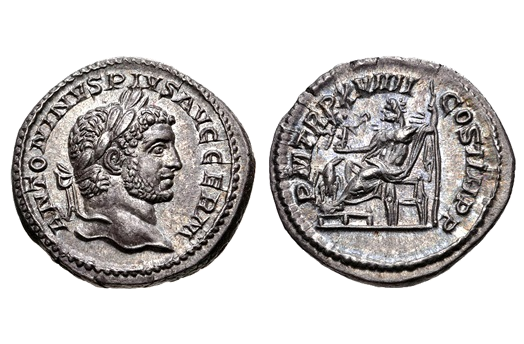
about ancient nomos
Ancient Nomos Art is a museum of galleries exhibiting ancient coins and ancient mint maps. The coin gallery displays the diverse art and history of hand-crafted ancient Greek, Roman, Byzantine, Persian and Medieval coinage. The ancient mints mapping gallery features Greek, Roman, Byzantine, Asia Minor and Medieval mint city regions and territories. Visitor's are welcome to explore, study and enjoy Ancient Nomos Art.

Imperial, Roman – 216 AD
Caracalla
From Ancient Galleries

Obverse: Laureate bust of Emperor Caracalla facing right.
Reverse: Jupiter seated left, holding winged Victory & scepter; Eagle at his feet looking up and to the right.
LEGEND
Obv: ANTONINVS PIVS AVG GERM, Laureate bust of Caracalla facing right. Rev: P M TR P XVIIII – COS IIII P P, Jupiter seated left, holding winged Victory & scepter; eagle at his feet.
The Roman emperor Caracalla was the eldest son of Septimius Severus and reigned jointly with his father from 198 AD until Severus’ death in 211 AD. For a short time he then ruled jointly with his younger brother Geta until he had him murdered later in 211 AD. Caracalla is remembered as one of the most notorious and unpleasant of emperors because of the massacres and persecutions he authorized and instigated throughout the Empire. Caracalla’s reign was also notable for the Constitutio Antoniniana (also called the Edict of Caracalla or the Antonine Constitution), granting Roman citizenship to all freemen throughout the Roman Empire, which according to historian Cassius Dio, was done for the purposes of raising tax revenue. He is also one of the emperors who commissioned a large public bath-house (thermae) in Rome. The remains of the Baths of Caracalla are still one of the major tourist attractions of the Italian capital. The above denarius depicts a remarkable portrait bust of Caracalla issued during the last year of his life. The specimen is perfectly centered and portrays a sharply struck and well detailed depiction of Jupiter seated. Jupiter is seated bare chested facing left, his feet rest on a low footstool, while holding Victory on his right hand. Victory is holding a wreath and about to crown Jupiter. Jupiter holds his scepter in his left hand as garment drapes over the arm. Jupiter’s feet appear to rest on a globe upon which and eagle stands facing with its head turned right. Interestingly, at about the time of Caracalla’s accession he ordered the Roman silver denarius currency be devalued by reducing the silver content. Subsequently, the silver purity of the denarius was decreased from 56.5% to 51.5%, the actual silver weight dropping from 1.81 grams to 1.66 grams – though the overall weight slightly increased. In 215 AD he introduced the antoninianus, a “double denarius” weighing 5.1 grams and containing 2.6 grams of silver – a purity of about 52%. Emperor Macrinus, who ruled after Caracalla, increased the silver purity of the denarius from 51.5% to 58%, and also increased the actual silver weight from 1.66 grams to 1.82 grams.
DOCUMENTATION
Value: Denarius. Metal: AR Silver. Weight: 3.64 grams. Mint: Rome. Date: 216 AD.
Attribution: Roman Imperial Coinage IV, 277c; RSC 343; Seaby Bulletin, March 1981, C130 (this coin).
Legend, Documentation and Attribution
